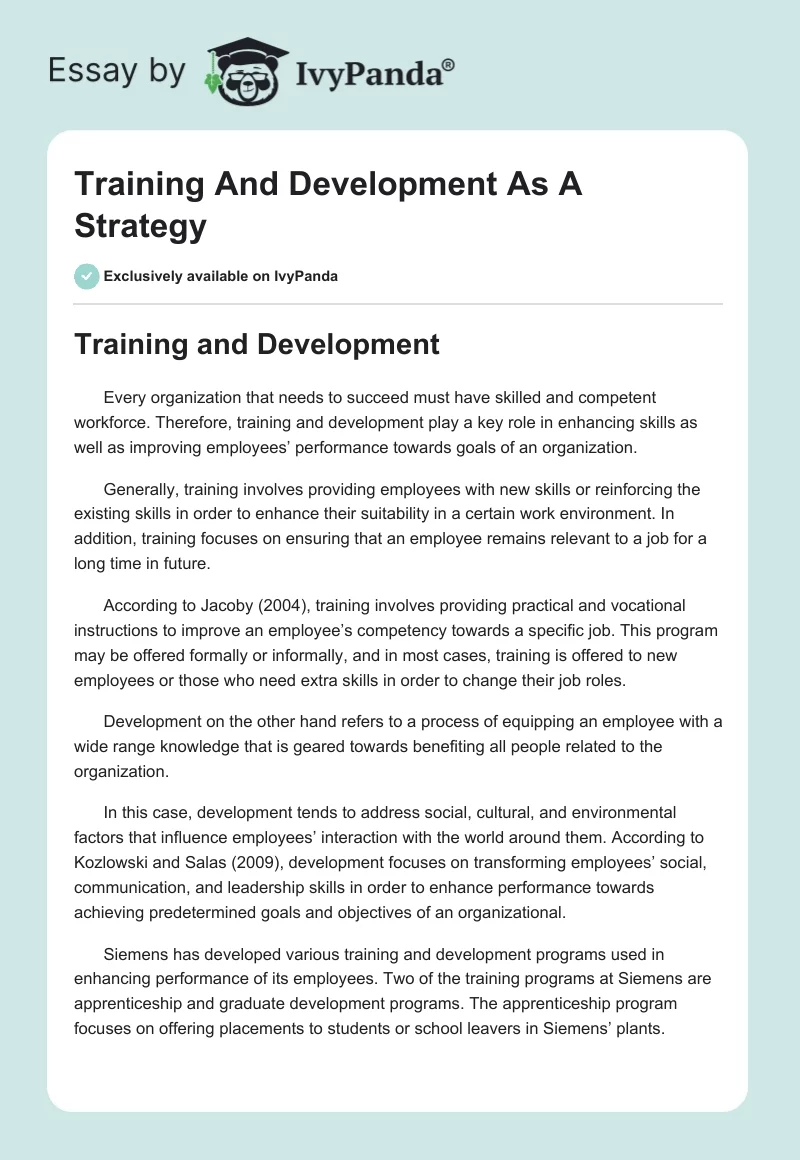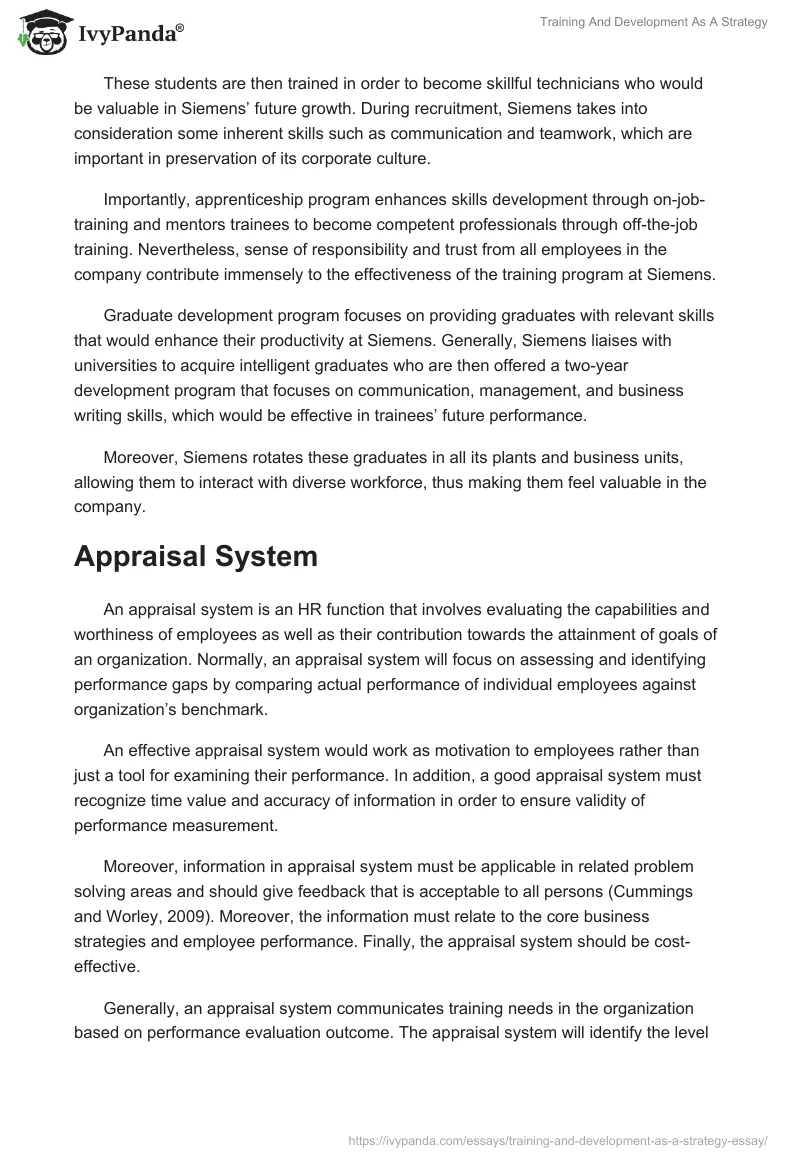Training and Development
Every organization that needs to succeed must have skilled and competent workforce. Therefore, training and development play a key role in enhancing skills as well as improving employees’ performance towards goals of an organization.
Generally, training involves providing employees with new skills or reinforcing the existing skills in order to enhance their suitability in a certain work environment. In addition, training focuses on ensuring that an employee remains relevant to a job for a long time in future.
According to Jacoby (2004), training involves providing practical and vocational instructions to improve an employee’s competency towards a specific job. This program may be offered formally or informally, and in most cases, training is offered to new employees or those who need extra skills in order to change their job roles.
Development on the other hand refers to a process of equipping an employee with a wide range knowledge that is geared towards benefiting all people related to the organization.
In this case, development tends to address social, cultural, and environmental factors that influence employees’ interaction with the world around them. According to Kozlowski and Salas (2009), development focuses on transforming employees’ social, communication, and leadership skills in order to enhance performance towards achieving predetermined goals and objectives of an organizational.
Siemens has developed various training and development programs used in enhancing performance of its employees. Two of the training programs at Siemens are apprenticeship and graduate development programs. The apprenticeship program focuses on offering placements to students or school leavers in Siemens’ plants.
These students are then trained in order to become skillful technicians who would be valuable in Siemens’ future growth. During recruitment, Siemens takes into consideration some inherent skills such as communication and teamwork, which are important in preservation of its corporate culture.
Importantly, apprenticeship program enhances skills development through on-job-training and mentors trainees to become competent professionals through off-the-job training. Nevertheless, sense of responsibility and trust from all employees in the company contribute immensely to the effectiveness of the training program at Siemens.
Graduate development program focuses on providing graduates with relevant skills that would enhance their productivity at Siemens. Generally, Siemens liaises with universities to acquire intelligent graduates who are then offered a two-year development program that focuses on communication, management, and business writing skills, which would be effective in trainees’ future performance.
Moreover, Siemens rotates these graduates in all its plants and business units, allowing them to interact with diverse workforce, thus making them feel valuable in the company.
Appraisal System
An appraisal system is an HR function that involves evaluating the capabilities and worthiness of employees as well as their contribution towards the attainment of goals of an organization. Normally, an appraisal system will focus on assessing and identifying performance gaps by comparing actual performance of individual employees against organization’s benchmark.
An effective appraisal system would work as motivation to employees rather than just a tool for examining their performance. In addition, a good appraisal system must recognize time value and accuracy of information in order to ensure validity of performance measurement.
Moreover, information in appraisal system must be applicable in related problem solving areas and should give feedback that is acceptable to all persons (Cummings and Worley, 2009). Moreover, the information must relate to the core business strategies and employee performance. Finally, the appraisal system should be cost-effective.
Generally, an appraisal system communicates training needs in the organization based on performance evaluation outcome. The appraisal system will identify the level of goal attainment within a given period and then communicate to the employee and the manager about the specific areas that need improvement.
In addition, a good appraisal system should encourage feedback from a wide range of sources in order to eliminate biasness and promote fairness in evaluation process. Engagement of employees in setting goals and performance targets is important, as it creates a sense of belonging in employees.
In this case, dialogue allows both the employee and the manager to design realistic strategies and course of action that would be instrumental in pursuing the predetermined goals and objectives.
Lastly, an appraisal system should incorporate self-appraisal by employees themselves in order to allow them to identify their strengths and weaknesses; the system will also allow them devise ways of sustaining strengths and countering weaknesses.
One example of a company that has used appraisal system in its HR department is Tata Motors. Tata employs a reward appraisal system that focuses on three areas, including promotion based on performance, offering incentives based on productivity and profitability, and long-term training.
Normally, employees select their goals or Key Results Areas (KRA), as they are commonly referred to, which are used to evaluate their performance after every six months. This appraisal system allows review of performance where incentives and salary increments are provided twice a year based on merit.
However, rewards in relation to designation are offered annually, with high performers receiving promotion as well as monetary rewards (Tata Motors, 2013). This system tends to motivate employees to deliver high performance, as they are made aware that their performance would be rewarded accordingly.
However, the rewards appraisal system tends to be unfavourable in contemporary HR environment due to the fact that it is one-dimensional. In other words, although the system allows employees to set their own goals it does not provide room for feedback on employees’ performance.
Therefore, the system concentrates on performance of employees in relation to goals of the organization with less consideration to their personal attributes and interests.
Training and Development Budget
A budget is simply a financial statement that summarizes revenues and expenditures within a given period, usually one year. Generally, a budget aims at fulfilling several roles in an organization, which include prediction of future receipts and expenses, decision support, and controlling financial performance.
Primarily, a budget contains predicted cash and non-cash items that guide the organization on how to raise and spend funds. Therefore, an organization would adjust its budget based on the available and expected funds by prioritizing those projects that fall within budget level.
When an organization has several projects to undertake, a budget facilitates decision-making by allowing the organization to schedule its projects on priority basis.
Lastly, an effective budget helps in monitoring performance by acting as a benchmark against which actual performance at the end of period will be compared. Nevertheless, actual performance will assist in assessing whether the organization had over-budgeted or under-budgeted and then adjusting the budget accordingly.
As organizations embrace culture of training and development in their establishments, they need a budget in order to enhance efficiency and effectiveness of their training programmes. Generally, many organizations would be encouraged to spend on training and development in order to avoid the cost of recruitment, which is usually high.
A typical training and development programme would require personnel/facilitators, facilities, and training tools, all of which must be budgeted for. Therefore, a well-drawn training and development budget would be a catalyst to the effectiveness of training programme. Lastly, competition in global market requires firms to attract and retain the most competent and skilled employees in order to remain competitive.
To do so, firms have to upgrade their training and development programmes, hence the need for a comprehensive and sound training budget. In modern organizations, spending on training and development is sometimes viewed as an investment that must bring returns in the future.
Indeed, according to Saks and Haccoun (2010), managers must conduct cost-benefit analysis on training and development as well as demonstrated that there would be positive returns on investment (ROI) at the end of the programme in order to qualify for a share of the budget.
One company that has embraced the use of training and development budget is Starbucks Corporation, which is the largest coffeehouse in the world. Normally, Starbucks concentrates on empowering its workforce through training and development to ensure that they offer the best service possible.
According to Mahdavi (2007), Starbucks’ training and development budget is bigger than its marketing budget. Therefore, the company believes that customers would be more attracted by a competent workforce than marketing campaign. For instance, Starbucks has an apprenticeship programme where it offers training to school leavers on a 2-year period.
Indeed, the enthusiasm and competency portrayed by Starbucks’ employees is a catalyst to the ‘feel good’ atmosphere experienced by Starbucks’ customers. Moreover, Starbucks ensures that its entire staff must undertake various training lessons including those related to making coffee in order to ensure it remains relevant to the changing consumer environment.
Reference List
Cummings, T & Worley, C 2009, Organization Development and Change, Cengage Learning, Ohio.
Jacoby, J 2004, Development and Training, Pearson Prentice Hall, New Jersey.
Kozlowski, S and Salas, W 2009, Learning, Training, and Development in Organizations, Taylor & Francis, London.
Mahdavi, S 2007, Secretes to success at Starbucks. Web.
Saks, A & Haccoun, R 2010, Managing Performance Through Training and Development, Cengage Learning, Ohio.
Tata Motors 2013, Tata Motors. Web.


